Leaf Physiological Responses and Early Senescence Are Linked to Reflectance Spectra in Salt-Sensitive Coastal Tree Species
Abstract
:1. Introduction
2. Materials and Methods
2.1. Experimental Approach: Tree Species and Salinity Treatments
2.2. Functional Traits, Leaf Loss, and Biomass
2.3. Osmotic and Leaf Water Potential
2.4. Leaf Gas Exchange, Chlorophyll Fluorescence, and Spectral Reflectance
2.5. Statistical Analysis
3. Results
3.1. Groundwater and Soil Chemistry
3.2. Functional Traits, Leaf Loss, and Biomass
3.3. Osmotic and Leaf Water Potential
3.4. Leaf Gas Exchange and Chlorophyll Fluorescence
3.5. Spectral Reflectance
4. Discussion
4.1. Salinity Treatments
4.2. Leaf Water Potential, Gas Exchange, Fluorescence, and Senescence
4.3. Links between Photosystem II and Leaf Reflectance
5. Conclusions
Author Contributions
Funding
Data Availability Statement
Acknowledgments
Conflicts of Interest
Appendix A
| Cl− | SO4− | NO3−N | Na+ | K+ | Mg+ | Ca+ | NH4−N | PO4−P | |
|---|---|---|---|---|---|---|---|---|---|
| TOWeR | 7.78 | 0.31 | 0.02 | 4.22 | 0.87 | 0.68 | 1.82 | 0.05 | <0.01 |
| 0.005 | 0.005 | <0.001 | 0.001 | 0.010 | 0.002 | 0.010 | <0.001 | - | |
| Control | 23.0 | 3.7 | 2.31 | 2.7 | 85.2 | 19.6 | 49.7 | 0.26 | 0.67 |
| 3.45 | 2.68 | 1.69 | 1.42 | 35.1 | 11.2 | 23.8 | 0.12 | 0.34 | |
| Salinity Stock (0.5–6 ppt) | 31,349 | 5546 | 14.78 | 18,308 | 635 | 2924 | 849 | - | - |
| 0.5 ppt | 493 | 144 | 3.79 | 134 | 0.69 | 44.2 | 105 | - | - |
| - | - | - | - | - | - | - | |||
| 1 ppt | 1184 | 248 | 1.79 | 335 | 0.82 | 69.4 | 39.7 | - | - |
| - | - | - | - | - | - | - | |||
| 2 ppt | 2051 | 396 | 2.04 | 599 | 1.27 | 105 | 44.7 | - | - |
| - | - | - | - | - | - | - | |||
| 3 ppt | 2972 | 622 | 2.44 | 861 | 2.29 | 143 | 73.1 | - | - |
| 572 | 95.5 | 0.76 | 169 | 0.31 | 21.5 | 7.92 | |||
| 4 ppt | 3108 | 615 | 3.54 | 889 | 2.10 | 173 | 79.1 | - | - |
| - | - | - | - | - | - | - | |||
| 5 ppt | 4363 | 863 | 4.46 | 1267 | 2.88 | 219 | 92.4 | - | - |
| - | - | - | - | - | - | - | |||
| 6 ppt | 5604 | 1126 | 4.41 | 1617 | 3.75 | 267 | 115 | - | - |
| - | - | - | - | - | - | - |
| Salinity Treatments (Mean + st. dev.) | ||||||||
|---|---|---|---|---|---|---|---|---|
| Soil Parameters | Control (n = 43) | 0.5 ppt (n = 5) | 1 ppt (n = 5) | 2 ppt (n = 5) | 3 ppt (n = 45) | 4 ppt (n = 5) | 5 ppt (n = 5) | 6 ppt (n = 5) |
| pH | 6.07 + 0.2 | 6.09 + 0.2 | 6.07 + 0.2 | 6.02 + 0.1 | 6.01 + 0.1 | 6.06 +0.2 | 6.02 + 0.1 | 6.06 + 0.1 |
| % soil moisture | 22.4 + 3.1 | 22.6 + 4.2 | 21.9 + 2.6 | 20.6 + 1.9 | 22.2 + 2.8 | 22.1 + 3.4 | 21.3 + 3.6 | 23.1 + 5.3 |
| AFDM g/g dry soil | 1.05 + 0.3 | 1.08 + 0.3 | 0.94 + 0.2 | 0.95 + 0.2 | 1.02 + 0.2 | 0.98 + 0.2 | 0.98 + 0.3 | 1.05 + 0.3 |
| Sp. Cond. µs/cm | 0.10 + 0.03 | 0.19 + 0.1 | 0.32 + 0.1 | 0.52 + 0.3 | 0.74 + 0.3 | 1.04 + 0.4 | 1.01 + 0.4 | 1.36 + 0.4 |
| Chloride (Cl−) µg/g | 40.9 + 52 | 178 + 96 | 360 + 145 | 588 + 254 | 896 + 249 | 1295 + 733 | 1016 + 89 | 1710 + 504 |
| Sulfate (SO4−) µg/g | 167 + 115 | 73.9 + 20 | 233 + 205 | 172 + 63 | 215 + 96 | 230 +191 | 138 + 71 | 316 + 116 |
| Sodium (Na−) µg/g | 55.5 + 14 | 126 + 50 | 229 + 94 | 336 + 130 | 502 + 121 | 703 + 342 | 609 + 65 | 956 + 260 |
| Calcium (Ca+) µg/g | 49.7 + 24 | 42.5 + 8.3 | 161 + 55 | 143 + 40 | 151 + 39 | 161 + 96 | 110 + 37 | 192 + 54 |
| Magnesium (Mg+) µg/g | 19.6 + 11 | 16.1 + 4.1 | 53.1 + 21 | 56.4 + 15 | 68.6 + 20 | 82.2 + 58 | 53.9 + 16 | 101 + 35 |
| Potassium (K+) µg/g | 85.2 + 35 | 83.3 + 28 | 123 + 57 | 125 + 21 | 136 + 37 | 150 + 81 | 111 + 41 | 158 + 26 |
| Ammonium (NH4+) mg/g | 0.26 + 0.1 | 0.24 + 0.1 | 0.21 + 0.1 | 0.33 + 0.1 | 0.292 + 0.2 | 0.46 + 0.2 | 0.327 + 0.2 | 0.48 + 0.1 |
| Nitrate (NO3−) µg/g | 2.31 + 1.7 | 1.85 + 0.6 | 1.9 + 0.3 | 3.73 + 3.9 | 2.57 + 1.4 | 2.11 + 0.7 | 2.31 + 1.8 | 2.37 + 1.3 |
| Phosphate (PO4−) mg/g | 0.67 + 0.3 | 0.61 + 0.2 | 0.68 + 0.4 | 0.82 + 0.5 | 0.705 + 0.3 | 0.66 + 0.4 | 0.60 + 0.1 | 0.81 + 0.4 |
| ACRU | NYSY | QUNI | JUVI | PITA | TADI | ||||||||
|---|---|---|---|---|---|---|---|---|---|---|---|---|---|
| Treatment | Mean | s.d. | Mean | s.d. | Mean | s.d. | Mean | s.d. | Mean | s.d. | Mean | s.d. | |
| AGB g | Control | 26.9 | 6.31 | 12.9 | 4.83 | 19.2 | 10.2 | 29.7 | 14.9 | 36.5 | 8.71 | 54.2 | 14.7 |
| 3 ppt | 26.2 | 10.3 | 22.5 | 7.44 | 14.2 | 7.03 | 32.5 | 20.7 | 35.9 | 10.1 | 51.3 | 8.56 | |
| BGB g | Control | 52.4 | 14.5 | 15.6 | 5.47 | 34.5 | 17.7 | 17.3 | 10.9 | 27.2 | 9.13 | 67.0 | 15.4 |
| 3 ppt | 38.2 | 21.0 | 29.9 | 9.23 | 31.3 | 15.9 | 14.8 | 10.2 | 26.4 | 5.39 | 70.5 | 16.3 | |
| LEAF MASS g | Control | 9.96 | 2.70 | 5.04 | 1.67 | 6.50 | 3.03 | 17.3 | 7.41 | 24.5 | 6.06 | 14.6 | 2.81 |
| 3 ppt | 12.4 | 2.97 | 7.78 | 2.43 | 5.45 | 2.63 | 20.7 | 12.1 | 23.0 | 7.29 | 13.8 | 3.27 | |
| LEAF AREA mm2 | Control | 1206 | 258 | 845 | 231 | 777 | 353 | 974 | 251 | 1598 | 531 | 2268 | 590 |
| 3 ppt | 1050 | 800 | 1200 | 403 | 664 | 293 | 1169 | 553 | 1319 | 23 | 2357 | 768 | |
| HGR cm/day | Control | 0.50 | 0.64 | 4.27 | 2.44 | 1.09 | 1.74 | 0.87 | 1.34 | 0.80 | 0.94 | 0.41 | 0.71 |
| 3 ppt | 0.27 | 0.56 | 4.27 | 3.75 | 0.61 | 0.62 | 0.96 | 0.93 | 0.66 | 0.86 | 0.41 | 0.73 | |
| DGR mm/day | Control | 0.83 | 0.38 | 2.56 | 1.82 | 1.43 | 1.32 | 0.93 | 0.32 | 0.46 | 0.28 | 0.51 | 0.23 |
| 3 ppt | 0.41 | 0.27 | 2.18 | 0.84 | 1.50 | 1.96 | 1.22 | 0.39 | 0.72 | 0.20 | 0.52 | 0.27 | |
| ROOT: SHOOT | Control | 3.17 | 1.20 | 2.05 | 0.61 | 2.89 | 0.70 | 1.44 | 0.34 | 2.15 | 0.75 | 1.84 | 0.69 |
| 3 ppt | 2.02 | 1.06 | 2.07 | 0.45 | 4.01 | 1.24 | 1.30 | 0.60 | 1.94 | 0.59 | 1.98 | 0.74 | |
| SLA mm2/mg | Control | 135 | 15.9 | 174 | 20.0 | 124 | 21.9 | 59.8 | 11.9 | 70.1 | 21.2 | 158 | 21.3 |
| 3 ppt | 172 | 34.0 | 175 | 37.2 | 128 | 18.8 | 61.6 | 13.1 | 65.8 | 16.9 | 175 | 27.5 | |
| LDMC mg/g | Control | 460 | 36.3 | 385 | 30.1 | 536 | 43.8 | 418 | 47.9 | 399 | 34.5 | 374 | 25.2 |
| 3 ppt | 503 | 84.7 | 385 | 48.8 | 526 | 44.2 | 423 | 52.7 | 409 | 53.3 | 368 | 30.9 | |
| %C | Control | 46.3 | 0.73 | - | - | - | - | 48.4 | 0.94 | 49.0 | 1.41 | 48.7 | 0.79 |
| 3 ppt | 44.1 | 3.69 | - | - | - | - | 48.0 | 0.59 | 47.8 | 0.94 | 49.3 | 1.30 | |
| %N | Control | 0.94 | 0.29 | - | - | - | - | 0.75 | 0.06 | 0.49 | 0.09 | 1.07 | 0.06 |
| 3 ppt | 1.20 | 0.34 | - | - | - | - | 0.74 | 0.14 | 0.46 | 0.07 | 1.35 | 0.24 | |
| C:N | Control | 53.4 | 14.1 | - | - | - | - | 64.9 | 5.45 | 104 | 17.0 | 45.6 | 2.12 |
| 3 ppt | 41.2 | 11.6 | - | - | - | - | 67.6 | 14.7 | 106 | 12.0 | 37.6 | 5.69 | |
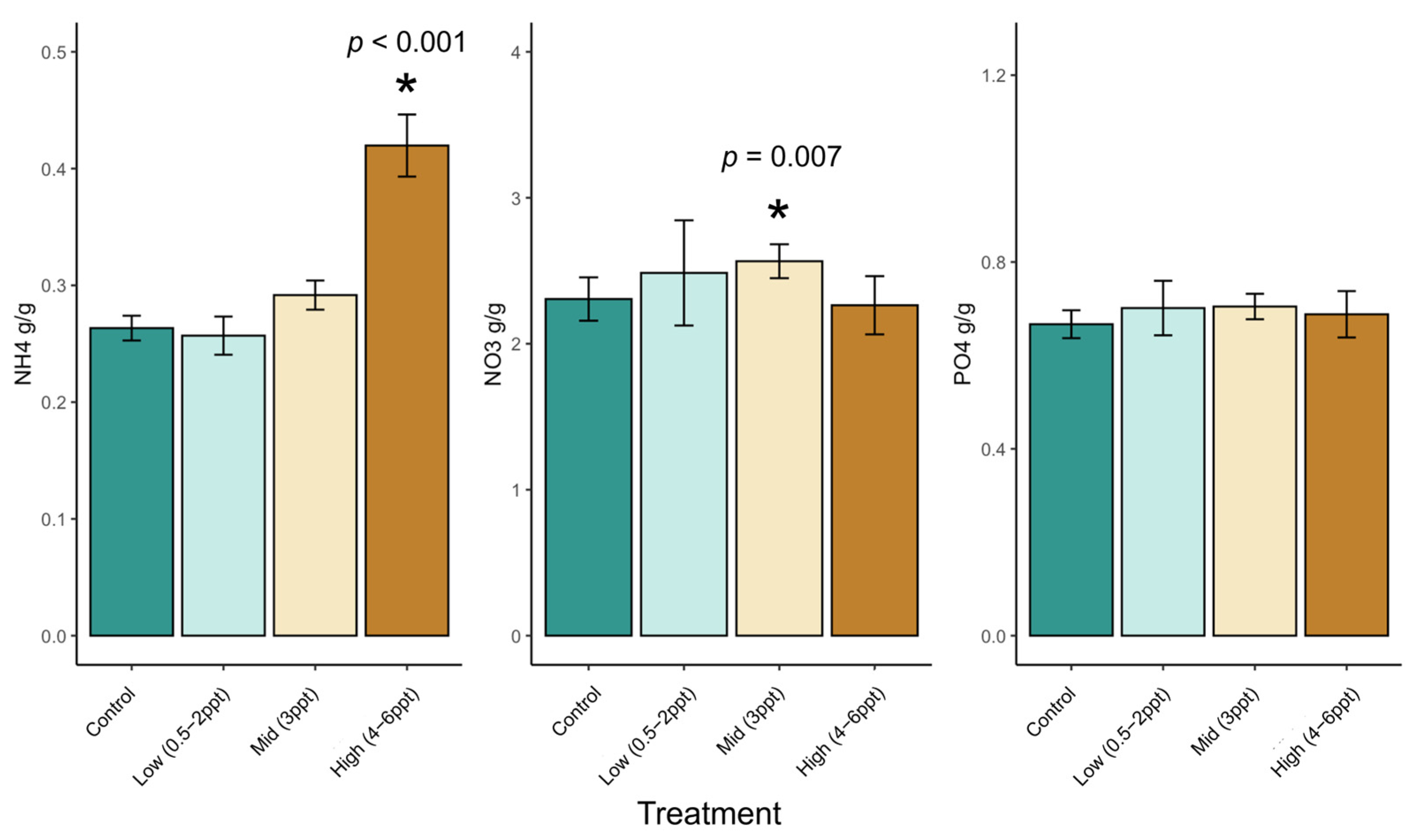
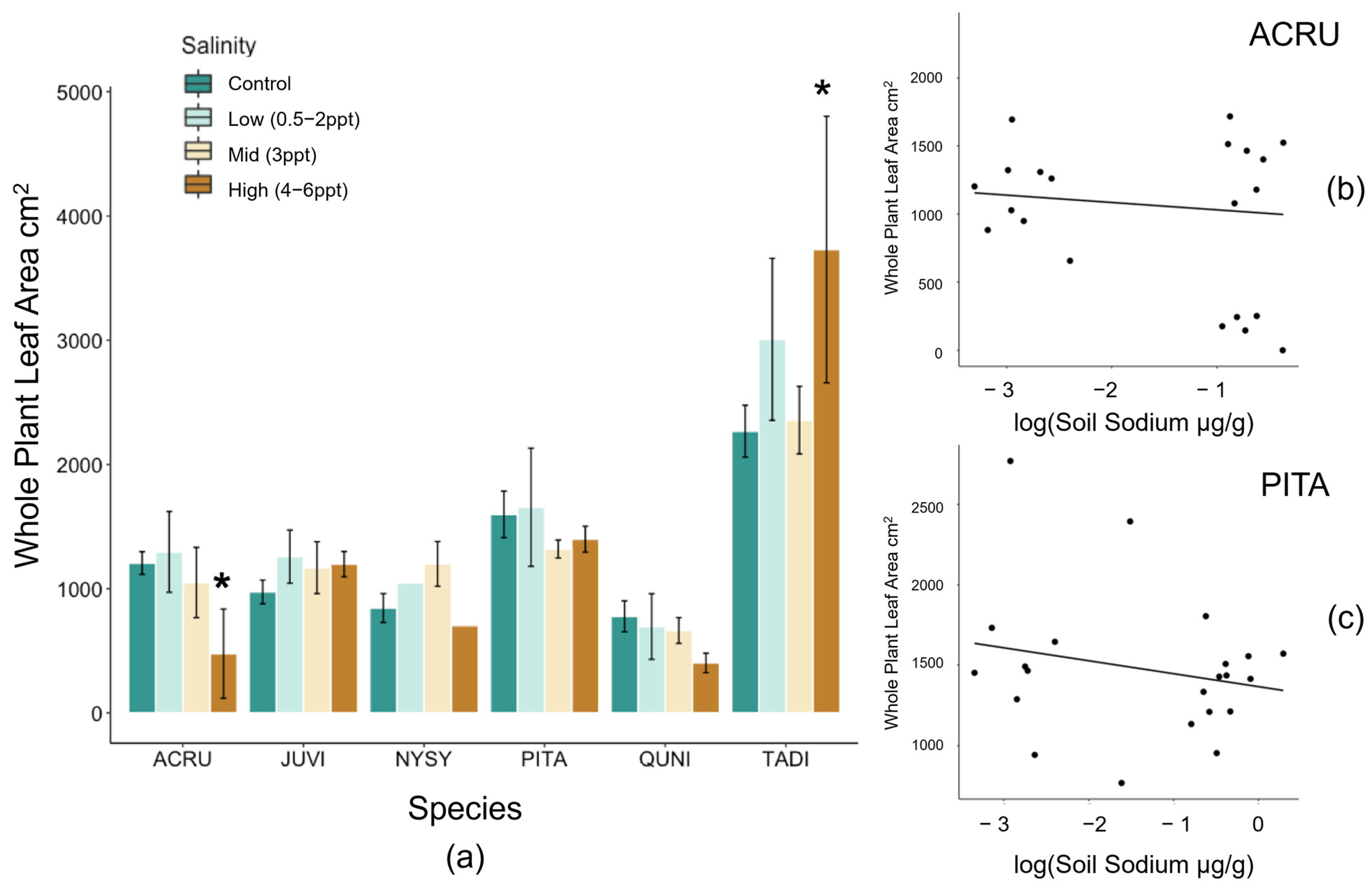
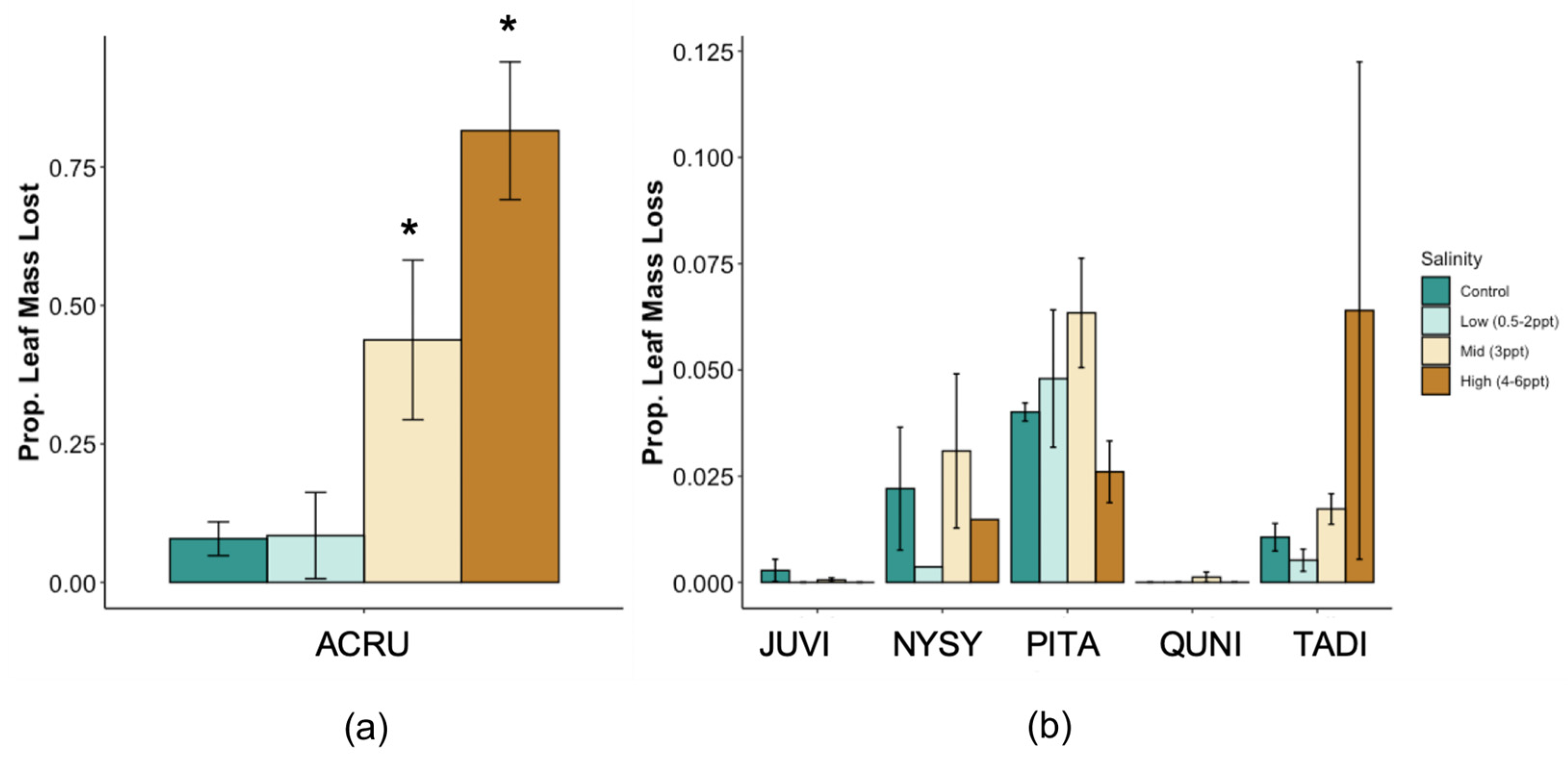
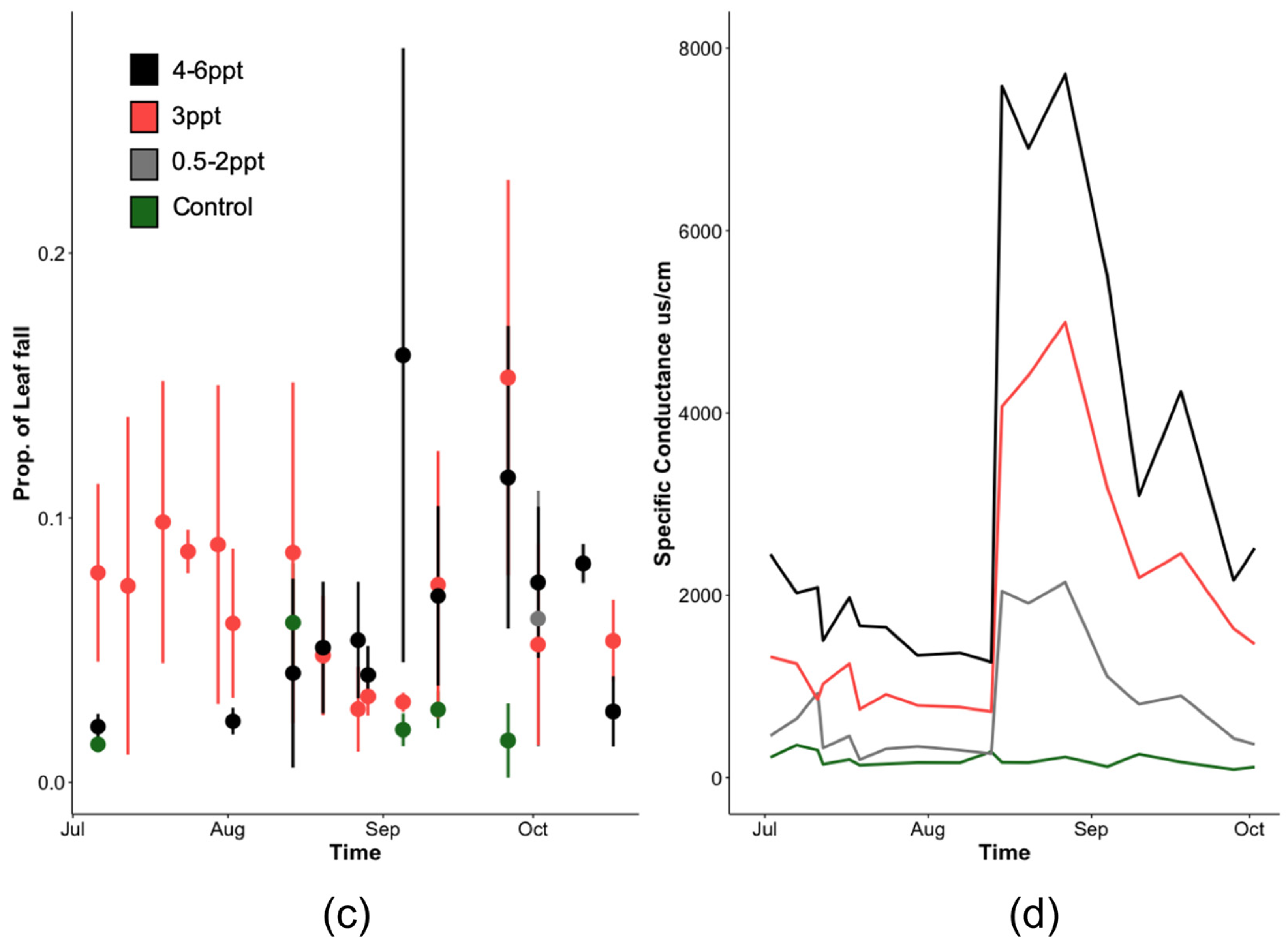


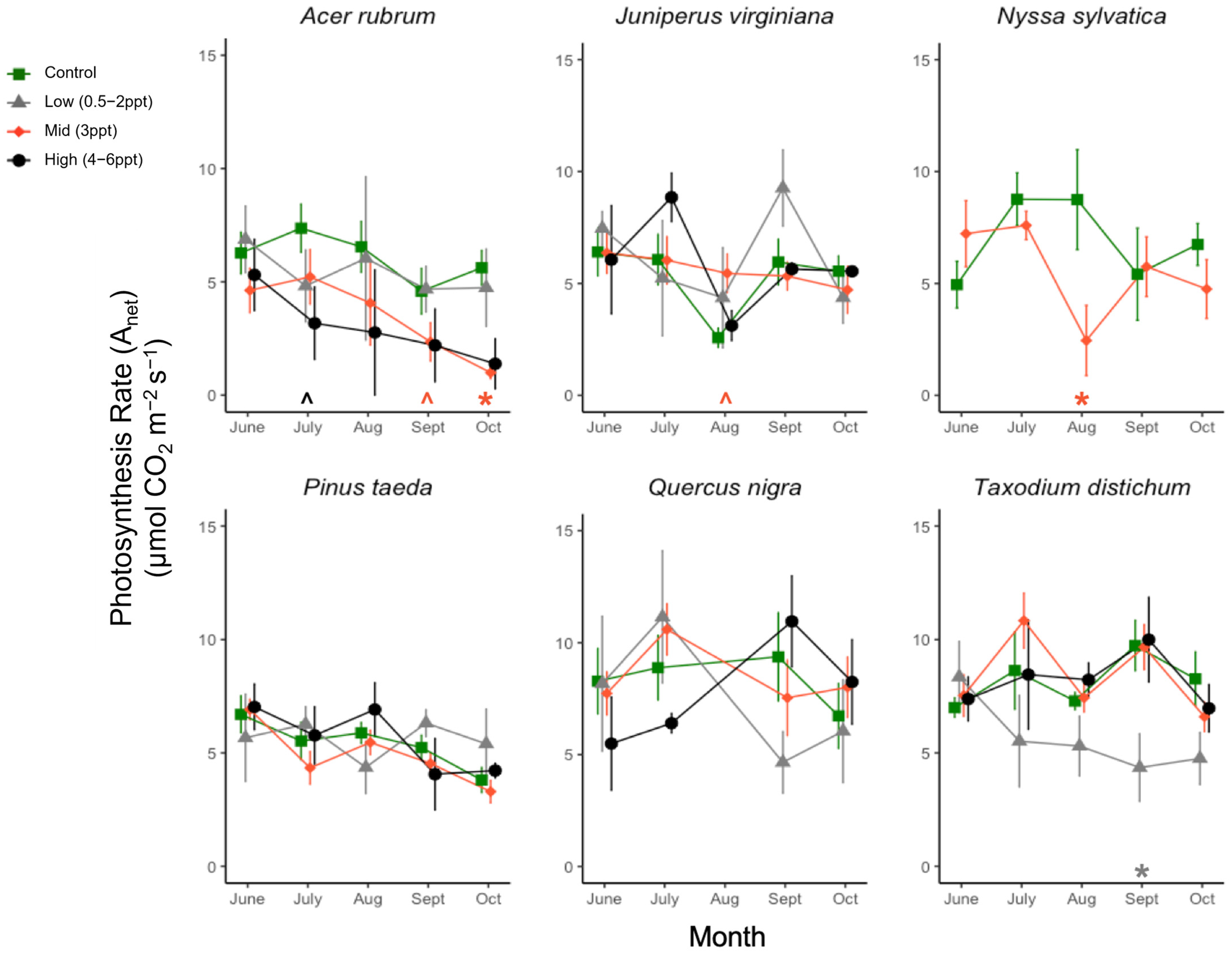

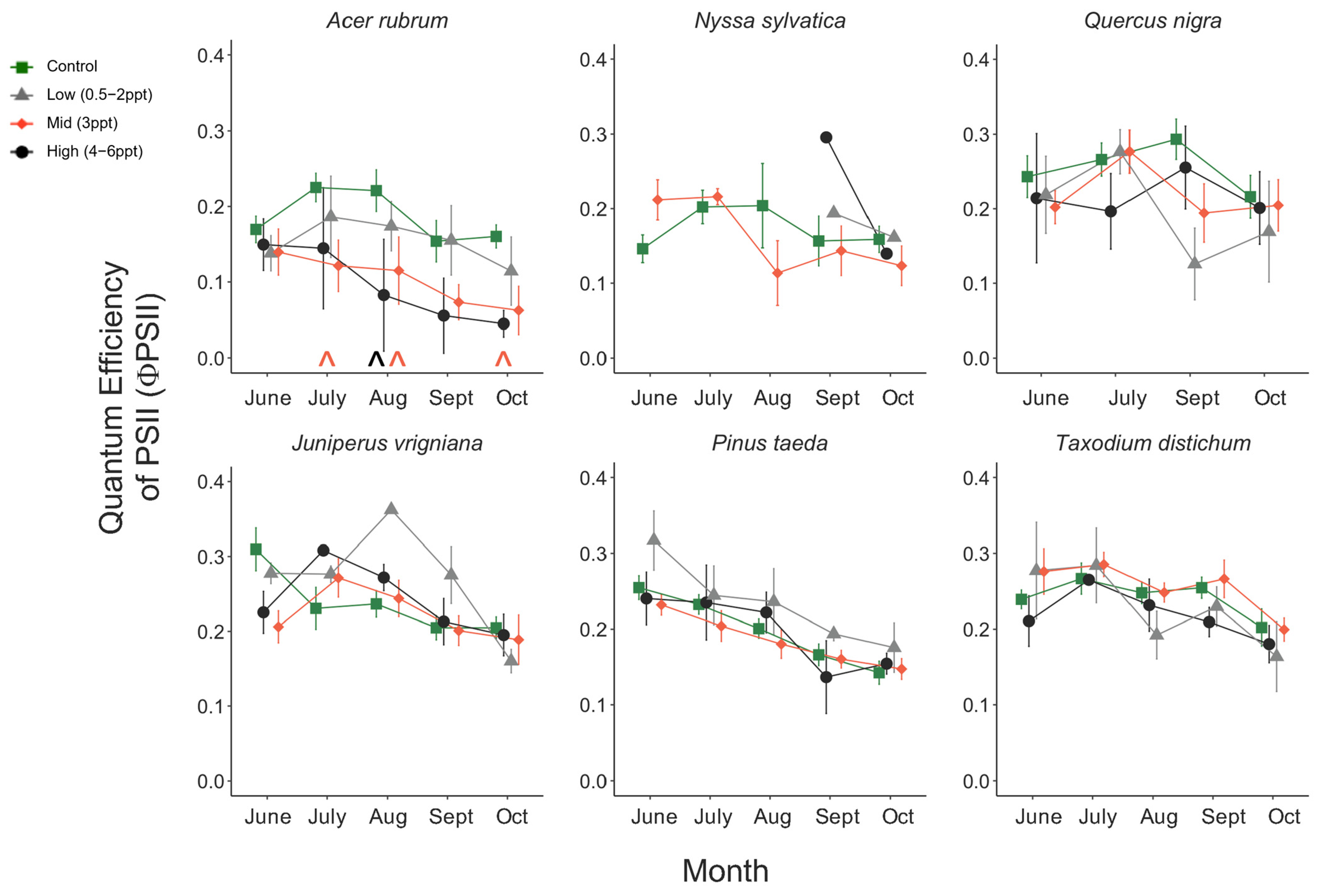

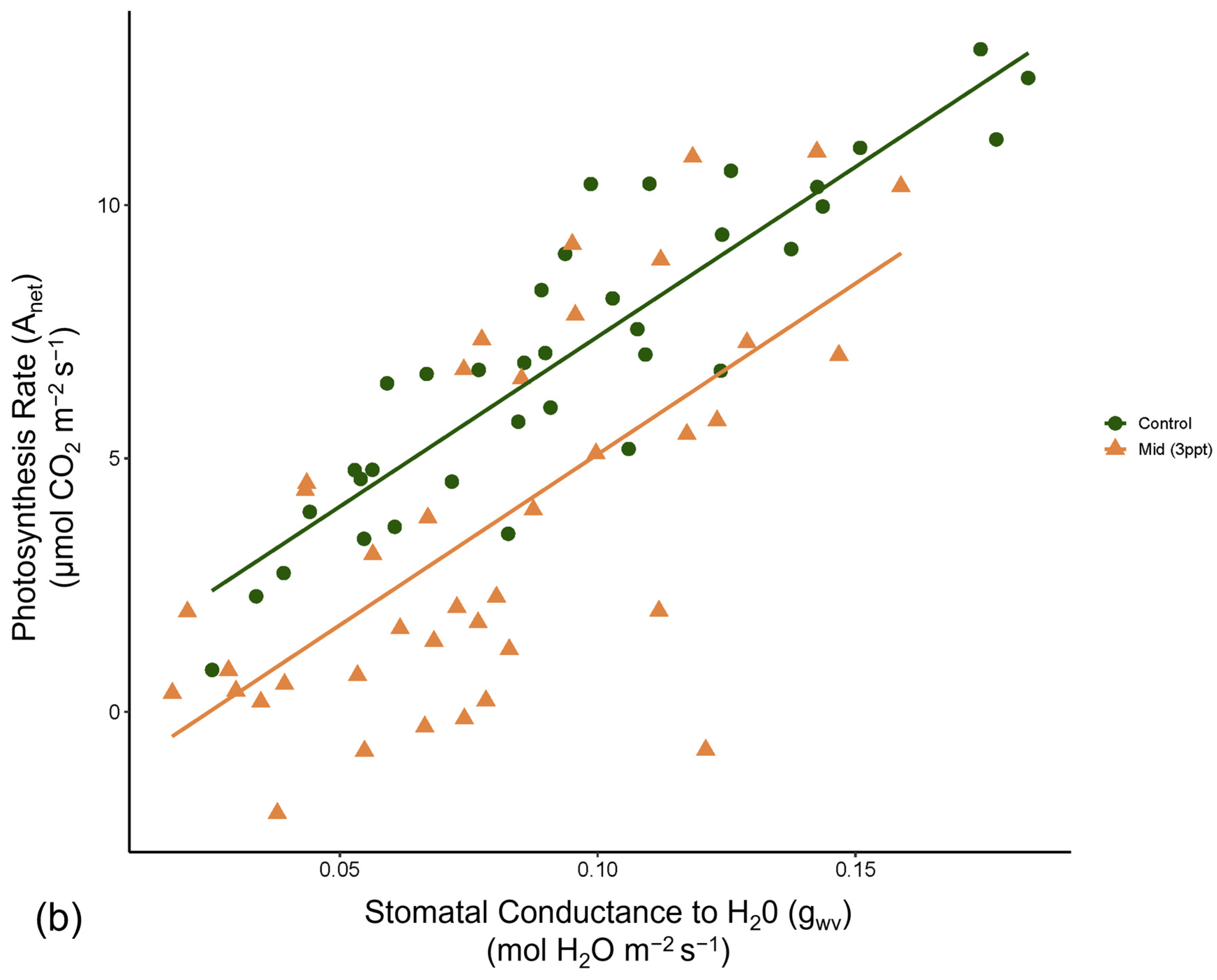
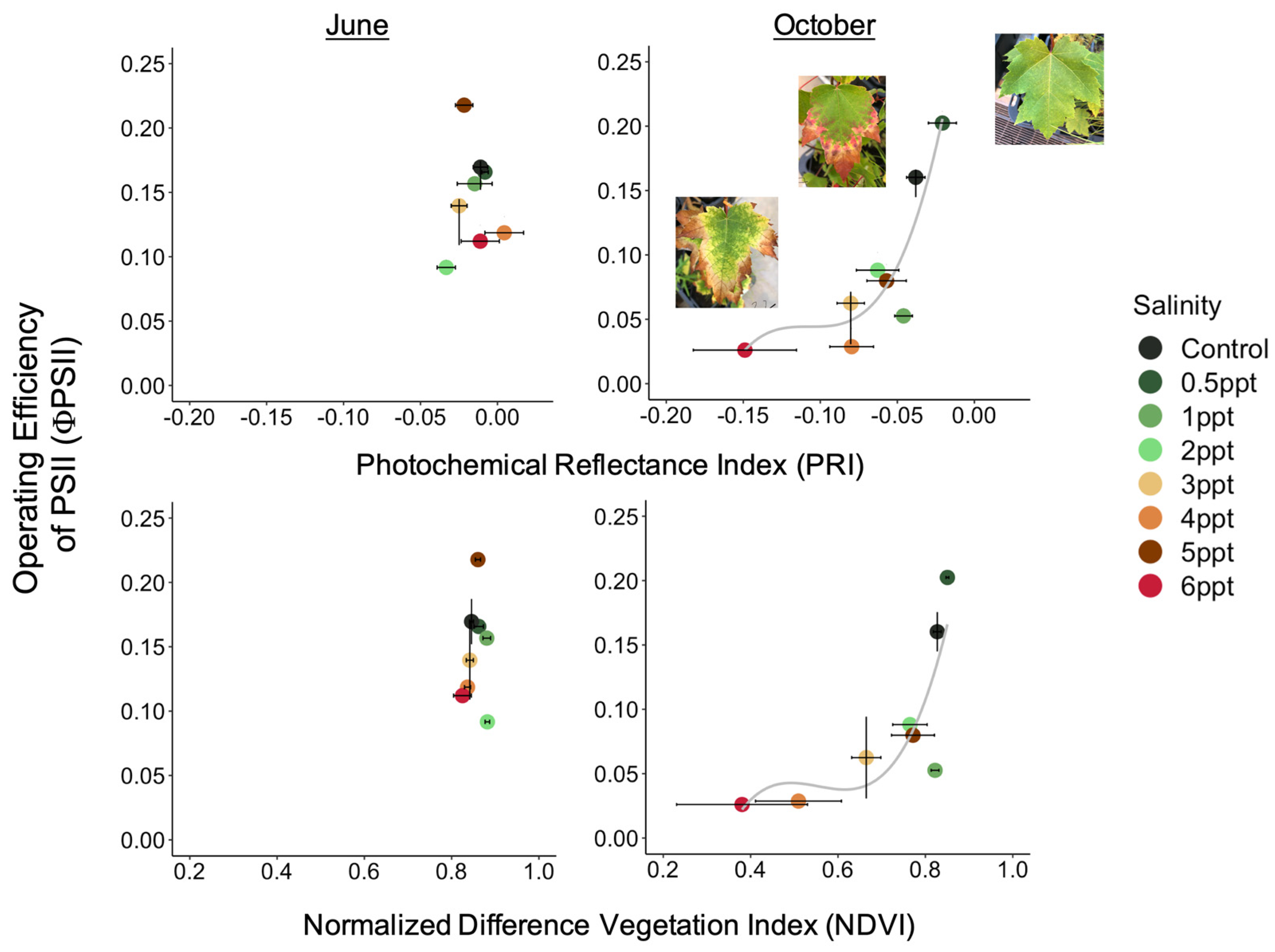
References
- Tully, K.; Gedan, K.; Epanchin-Niell, R.; Strong, A.; Bernhardt, E.S.; Bendor, T.; Mitchell, M.; Kominoski, J.; Jordan, T.E.; Neubauer, S.C.; et al. The Invisible Flood: The Chemistry, Ecology, and Social Implications of Coastal Saltwater Intrusion. BioScience 2019, 69, 368–378. [Google Scholar] [CrossRef]
- Kirwan, M.L.; Gedan, K.B. Sea-Level Driven Land Conversion and the Formation of Ghost Forests. Nat. Clim. Chang. 2019, 9, 450–457. [Google Scholar] [CrossRef]
- Williams, K.; Macdonald, M.; Da Silveira, L.; Sternberg, L. Interactions of Storm, Drought, and Sea-Level Rise on Coastal Forest: A Case Study. J. Coast. Res. 2003, 19, 1116–1121. [Google Scholar]
- White, E.E., Jr.; Ury, E.A.; Bernhardt, E.S.; Yang, X. Climate Change Driving Widespread Loss of Coastal Forested Wetlands Throughout the North American Coastal Plain. Ecosystems 2021, 25, 812–827. [Google Scholar] [CrossRef]
- Munns, R.; Tester, M. Mechanisms of Salinity Tolerance. Annu. Rev. Plant Biol. 2008, 59, 651–681. [Google Scholar] [CrossRef] [PubMed]
- Parida, A.K.; Das, A.B. Salt Tolerance and Salinity Effects on Plants: A Review. Ecotoxicol. Environ. Saf. 2005, 60, 324–349. [Google Scholar] [CrossRef]
- Duberstein, J.A.; Krauss, K.W.; Baldwin, M.J.; Allen, S.T.; Conner, W.H.; Salter, J.S.; Miloshis, M. Small Gradients in Salinity Have Large Effects on Stand Water Use in Freshwater Wetland Forests. For. Ecol. Manag. 2020, 473, 118308. [Google Scholar] [CrossRef]
- Ollinger, S.V. Sources of Variability in Canopy Reflectance and the Convergent Properties of Plants. New Phytol. 2011, 189, 375–394. [Google Scholar] [CrossRef]
- Zhang, T.T.; Zeng, S.L.; Gao, Y.; Ouyang, Z.T.; Li, B.; Fang, C.M.; Zhao, B. Using Hyperspectral Vegetation Indices as a Proxy to Monitor Soil Salinity. Ecol. Indic. 2011, 11, 1552–1562. [Google Scholar] [CrossRef]
- Anderson, S.M.; Ury, E.A.; Taillie, P.J.; Ungberg, E.A.; Moorman, C.E.; Poulter, B.; Ardón, M.; Bernhardt, E.S.; Wright, J.P. Salinity Thresholds for Understory Plants in Coastal Wetlands. Plant Ecol. 2022, 223, 323–337. [Google Scholar] [CrossRef]
- Parihar, P.; Singh, S.; Singh, R.; Singh, V.P.; Prasad, S.M. Effect of Salinity Stress on Plants and Its Tolerance Strategies: A Review. Environ. Sci. Pollut. Res. 2015, 22, 4056–4075. [Google Scholar] [CrossRef]
- Tolliver, K.S.; Martin, D.W.; Young, D.R. Freshwater and Saltwater Flooding Response for Woody Species Common to Barrier Island Swales. Wetlands 1997, 17, 10–18. [Google Scholar] [CrossRef]
- Elmqvist, T.; Folke, C.; Nystrom, M.; Peterson, G.; Bengtsson, J.; Walker, B.; Norberg, J. Response Diversity, Ecosystem Change, and Resilience RID C-1309-2008 RID F-2386-2011. Front. Ecol. Environ. 2003, 1, 488–494. [Google Scholar] [CrossRef]
- van Dijk, G.; Smolders, A.J.P.; Loeb, R.; Bout, A.; Roelofs, J.G.M.; Lamers, L.P.M. Salinization of Coastal Freshwater Wetlands; Effects of Constant versus Fluctuating Salinity on Sediment Biogeochemistry. Biogeochemistry 2015, 126, 71–84. [Google Scholar] [CrossRef]
- Isayenkov, S.V.; Maathuis, F.J.M. Plant Salinity Stress: Many Unanswered Questions Remain. Front. Plant Sci. 2019, 10, 80. [Google Scholar] [CrossRef]
- Brewer, T. Remote Sensing of Vegetation: Principles, Techniques and Applications. Soil Use Manag. 2012, 28, 134. [Google Scholar] [CrossRef]
- Kozlowski, T.T. Responses of Woody Plants to Flooding and Salinity. Tree Physiol. Mon. 1997, 17, 490. [Google Scholar]
- Domec, J.-C.; King, J.S.; Carmichael, M.J.; Overby, A.T.; Wortemann, R.; Smith, W.K.; Miao, G.; Noormets, A.; Johnson, D.M. Aquaporins, and Not Changes in Root Structure, Provide New Insights into Physiological Responses to Drought, Flooding, and Salinity. J. Exp. Bot. 2021, 72, 4489–4501. [Google Scholar] [CrossRef]
- Conner, W.H. The Effect of Salinity and Waterlogging on Growth and Survival of Baldcypress and Chinese Tallow Seedlings. J. Coast. Res. 1994, 10, 1045–1049. [Google Scholar]
- Poulter, B.; Christensen, N.L.; Qian, S.S. Tolerance of Pinus taeda and Pinus serotina to Low Salinity and Flooding: Implications for Equilibrium Vegetation Dynamics. J. Veg. Sci. 2008, 19, 15–22. [Google Scholar] [CrossRef]
- Stimson, H.C.; Breshears, D.D.; Ustin, S.L.; Kefauver, S.C. Spectral Sensing of Foliar Water Conditions in Two Co-Occurring Conifer Species: Pinus edulis and Juniperus monosperma. Remote Sens. Environ. 2005, 96, 108–118. [Google Scholar] [CrossRef]
- Allen, J.A.; Pezeshki, S.R.; Chambers, J.L. Interaction of Flooding and Salinity Stress on Baldcypress (Taxodium distichum). Tree Physiol. 1996, 16, 307–313. [Google Scholar] [CrossRef] [PubMed]
- Day, R.H.; From, A.S.; Johnson, D.J.; Krauss, K.W. Interactive Effects of Salinity and Hydrology on Radial Growth of Bald Cypress (Taxodium distichum (L.) Rich.) in Coastal Louisiana, USA. Forests 2024, 15, 1258. [Google Scholar] [CrossRef]
- Douglas, B.C.; Peltier, W.R. The Puzzle of Global Sea-Level Rise. Cit. Phys. Today 2002, 55, 11. [Google Scholar] [CrossRef]
- Munns, R.; Passioura, J.B.; Colmer, T.D.; Byrt, C.S. Osmotic Adjustment and Energy Limitations to Plant Growth in Saline Soil. New Phytol. 2019, 225, 1091–1096. [Google Scholar] [CrossRef]
- Pezeshki, S.R. Response of Pinus taeda L. to Soil Flooding and Salinity. Ann. Sci. For. 1992, 49, 149–159. [Google Scholar]
- Naumann, J.C.; Young, D.R.; Anderson, J.E. Leaf Chlorophyll Fluorescence, Reflectance, and Physiological Response to Freshwater and Saltwater Flooding in the Evergreen Shrub, Myrica cerifera. Environ. Exp. Bot. 2008, 63, 402–409. [Google Scholar] [CrossRef]
- Flexas, J.; Medrano, H. Drought-inhibition of Photosynthesis in C3 Plants: Stomatal and Non-stomatal Limitations Revisited. Ann. Bot. 2002, 89, 183–189. [Google Scholar] [CrossRef]
- Powell, A.S.; Jackson, L.; Ardón, M. Disentangling the Effects of Drought, Salinity, and Sulfate on Baldcypress Growth in a Coastal Plain Restored Wetland. Restor. Ecol. 2016, 24, 548–557. [Google Scholar] [CrossRef]
- Stiller, V. Soil Salinity and Drought Alter Wood Density and Vulnerability to Xylem Cavitation of Baldcypress (Taxodium distichum (L.) Rich.) Seedlings. Environ. Exp. Bot. 2009, 67, 164–171. [Google Scholar] [CrossRef]
- Seyfried, G.S.; Chow, A.T.; O’Halloran, T.L. Salinization, Inundation and Tree Mortality Interact to Affect Greenhouse Gas Emissions from Stressed Coastal Forests. Soil Biol. Biochem. 2023, 184, 109101. [Google Scholar] [CrossRef]
- Zhai, L.; Krauss, K.W.; Liu, X.; Duberstein, J.A.; Conner, W.H.; DeAngelis, D.L.; Sternberg, L.d.S.L. Growth Stress Response to Sea Level Rise in Species with Contrasting Functional Traits: A Case Study in Tidal Freshwater Forested Wetlands. Environ. Exp. Bot. 2018, 155, 378–386. [Google Scholar] [CrossRef]
- Brinson, M.M.; Christian, R.R.; Blum, L.K.; Estuaries, S.; Odum, W.E.; Symposium, M.; Blum, L.K. Multiple States in the Sea-Level Induced Transition from Terrestrial Forest to Estuary. Estuaries 1995, 18, 648–659. [Google Scholar]
- Ury, E.A.; Anderson, S.M.; Peet, R.K.; Bernhardt, E.S.; Wright, J.P. Succession, Regression and Loss: Does Evidence of Saltwater Exposure Explain Recent Changes in the Tree Communities of North Carolina’s Coastal Plain? Ann. Bot. 2019, 125, 255–263. [Google Scholar] [CrossRef]
- Carmichael, M.J.; Smith, W.K. Growing Season Ecophysiology of Taxodium distichum (L.) Rich. (Bald cypress) Saplings in a Restored Wetland: A Baseline for Restoration Practice. Botany 2016, 94, 1115–1125. [Google Scholar] [CrossRef]
- Maxwell, K.; Johnson, G.N. Chlorophyll Fluorescence—A Practical Guide. J. Exp. Bot. 2000, 51, 659–668. [Google Scholar] [CrossRef]
- Baker, N.R. Chlorophyll Fluorescence: A Probe of Photosynthesis In Vivo. Annu. Rev. Plant Biol. 2008, 59, 89–113. [Google Scholar] [CrossRef]
- Murchie, E.H.; Lawson, T. Chlorophyll Fluorescence Analysis: A Guide to Good Practice and Understanding Some New Applications. J. Exp. Bot. 2013, 64, 3983–3998. [Google Scholar] [CrossRef]
- Zinnert, J.C.; Nelson, J.D.; Hoffman, A.M. Effects of Salinity on Physiological Responses and the Photochemical Reflectance Index in Two Co-Occurring Coastal Shrubs. Plant Soil 2012, 354, 45–55. [Google Scholar] [CrossRef]
- Naumann, J.C.; Anderson, J.E.; Young, D.R. Linking Physiological Responses, Chlorophyll Fluorescence and Hyperspectral Imagery to Detect Salinity Stress Using the Physiological Reflectance Index in the Coastal Shrub, Myrica cerifera. Remote Sens. Environ. 2008, 112, 3865–3875. [Google Scholar] [CrossRef]
- Negrão, S.; Schmöckel, S.M.; Tester, M. Evaluating Physiological Responses of Plants to Salinity Stress. Ann. Bot. 2017, 119, 1–11. [Google Scholar] [CrossRef] [PubMed]
- Peñuelas, J.; Filella, L. Technical Focus: Visible and near-Infrared Reflectance Techniques for Diagnosing Plant Physiological Status. Trends Plant Sci. 1998, 3, 151–156. [Google Scholar] [CrossRef]
- Naumann, J.C.; Young, D.R.; Anderson, J.E. Spatial Variations in Salinity Stress across a Coastal Landscape Using Vegetation Indices Derived from Hyperspectral Imagery. Plant Ecol. 2009, 202, 285–297. [Google Scholar] [CrossRef]
- Pezeshki, S.R.; Delaune, R.D.; Patrick, W.H. Flooding and Saltwater Intrusion: Potential Effects on Survival and Productivity of Wetland Forests along the U.S. Gulf Coast. For. Ecol. Manag. 1990, 33–34, 287–301. [Google Scholar] [CrossRef]
- Krauss, K.W.; Duberstein, J.A.; Doyle, T.W.; Conner, W.H.; Day, R.H.; Inabinette, L.W.; Whitbeck, J.L. Site Condition, Structure, and Growth of Baldcypress along Tidal/Non-Tidal Salinity Gradients. Wetlands 2009, 29, 505–519. [Google Scholar] [CrossRef]
- McLeod, K.W.; McCarron, J.K.; Conner, W.H. Photosynthesis and Water Relations of Four Oak Species: Impact of Flooding and Salinity. Trees 1999, 13, 178. [Google Scholar] [CrossRef]
- Waters, P.; Dahl, E. Nordic Society Oikos Ecological Salinity Boundaries. Nord. Soc. Oikos 1956, 7, 1–21. [Google Scholar]
- Ardón, M.; Morse, J.L.; Colman, B.P.; Bernhardt, E.S. Drought-Induced Saltwater Incursion Leads to Increased Wetland Nitrogen Export. Glob. Chang. Biol. 2013, 19, 2976–2985. [Google Scholar] [CrossRef]
- Pérez-Harguindeguy, N.; Díaz, S.; Garnier, E.; Lavorel, S.; Poorter, H.; Jaureguiberry, P.; Bret-Harte, M.S.; Cornwell, W.K.; Craine, J.M.; Gurvich, D.E.; et al. Corrigendum: New Handbook for Standardised Measurement of Plant Functional Traits Worldwide (Australian Journal of Botany (2013) 61:3 (167–234) DOI: 10.1071/BT12225). Aust. J. Bot. 2016, 64, 715–716. [Google Scholar] [CrossRef]
- Naumann, J.C.; Young, D.R.; Anderson, J.E. Linking Leaf Chlorophyll Fluorescence Properties to Physiological Responses for Detection of Salt and Drought Stress in Coastal Plant Species. Physiol. Plant. 2007, 131, 422–433. [Google Scholar] [CrossRef]
- Richter, H. Water Relations of Plants in the Field: Some Comments on the Measurement of Selected Parameters. J. Exp. Bot. 1997, 48, 1–7. [Google Scholar] [CrossRef]
- Heberling, J.M.; Fridley, J.D. Invaders Do Not Require High Resource Levels to Maintain Physiological Advantages in a Temperate Deciduous Forest. Ecology 2016, 97, 874–884. [Google Scholar] [CrossRef] [PubMed]
- Farquhar, G.D.; O’Leary, M.H.; Berry, J.A. On the Relationship between Carbon Isotope Discrimination and the Intercellular Carbon Dioxide Concentration in Leaves. Aust. J. Plant Physiol. 1982, 9, 121–137. [Google Scholar] [CrossRef]
- R Core Team. R: A Language and Environment for Statistical Computing; R Foundation for Statistical Computing: Vienna, Austria, 2019. [Google Scholar]
- Penuelas, J.; Llusia, J.; Pinol, J.; Filella, I. Photochemical Reflectance Index and Leaf Photosynthetic Radiation-Use-Efficiency Assessment in Mediterranean Trees. Int. J. Remote Sens. 1997, 18, 2863–2868. [Google Scholar] [CrossRef]
- Gamon, J.A.; Peñuelas, J.; Field, C.B. A Narrow-Waveband Spectral Index That Tracks Diurnal Changes in Photosynthetic Efficiency. Remote Sens. Environ. 1992, 41, 35–44. [Google Scholar] [CrossRef]
- Koc, A.; Henriksson, T.; Chawade, A. Specalyzer-An Interactive Online Tool to Analyze Spectral Reflectance Measurements. PeerJ 2018, 2018, e5031. [Google Scholar] [CrossRef]
- Bates, D.; Mächler, M.; Bolker, B.; Walker, S. Fitting Linear Mixed-Effects Models Using Lme4. J. Stat. Softw. 2015, 67, 1–48. [Google Scholar] [CrossRef]
- Wickham, H.; Chang, W.; Henry, L.; Pedersen, T.L.; Takahashi, K.; Wilke, C.; Woo, K.; Yutani, H.; Dunnington, D.; van den Brand, T.; et al. Ggplot2: Create Elegant Data Visualisations Using the Grammar of Graphics 2024. Available online: https://ggplot2.tidyverse.org/reference/ggplot2-package.html (accessed on 19 October 2018).
- RStudio Team. RStudio: Integrated Development for R; RStudio, Inc.: Boston, MA, USA, 2019; Available online: http://www.rstudio.com/ (accessed on 19 October 2018).
- Krings, A. Contributions to the Flora of Nags Head Woods, I: Key to the Trees and Shrubs. Vulpia 2003, 2, 1–14. [Google Scholar]
- Conner, W.H.; Askew, G.R. Impact of Saltwater Flooding on Red Maple, Redbay, and Chinese Tallo Seedlings. Castanea 1993, 58, 214–219. [Google Scholar]
- Poulter, B.; Qian, S.S.; Christensen, N.L. Determinants of Coastal Treeline and the Role of Abiotic and Biotic Interactions. Plant Ecol. 2009, 202, 55–66. [Google Scholar] [CrossRef]
- Ahmad, P.; Prasad, M.N.V.; Azooz, M.M. Salt Stress in Plants: Signalling, Omics and Adaptations; Springer: Berlin/Heidelberg, Germany, 2014; ISBN 978-1-4614-6108-1. [Google Scholar]
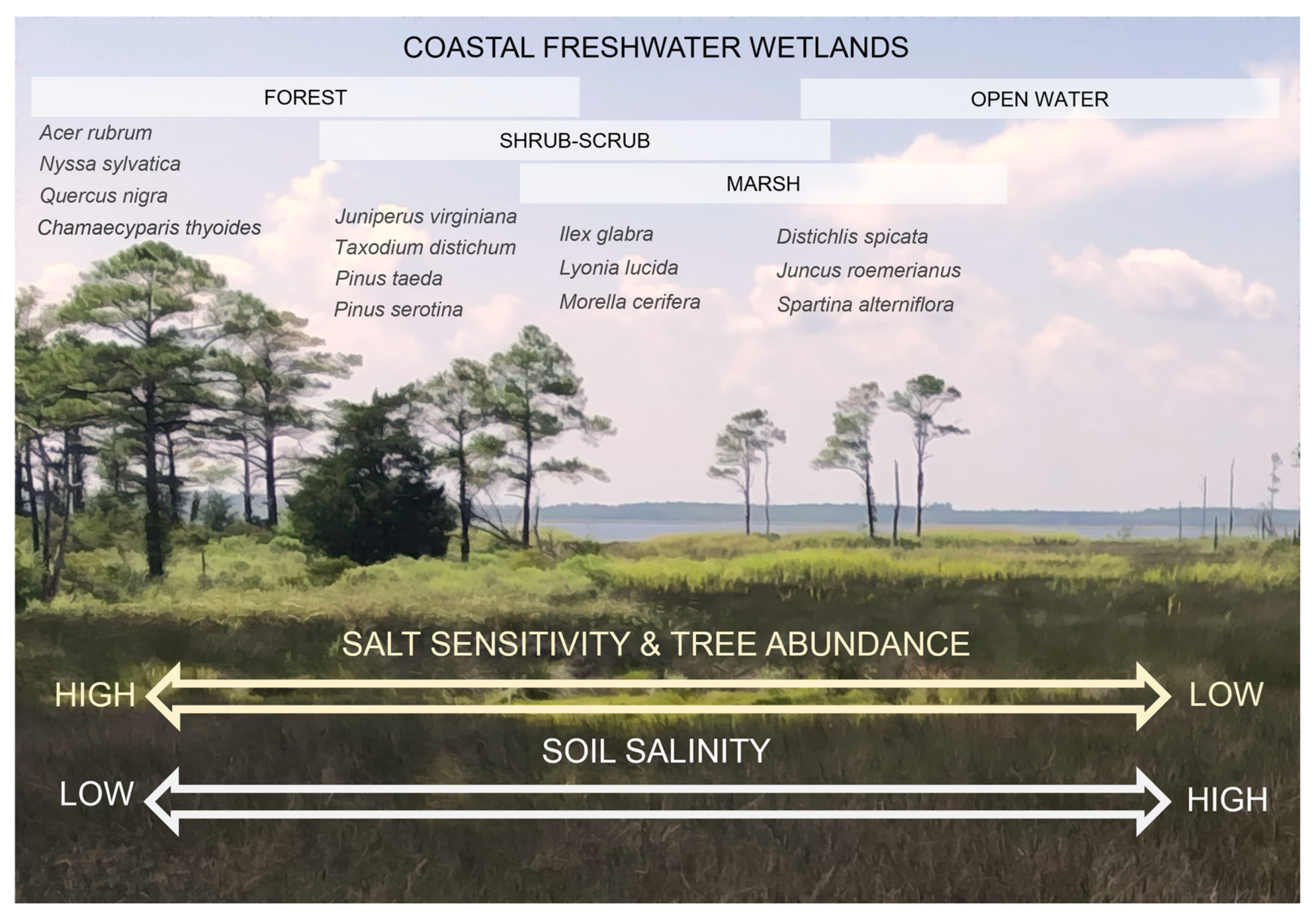
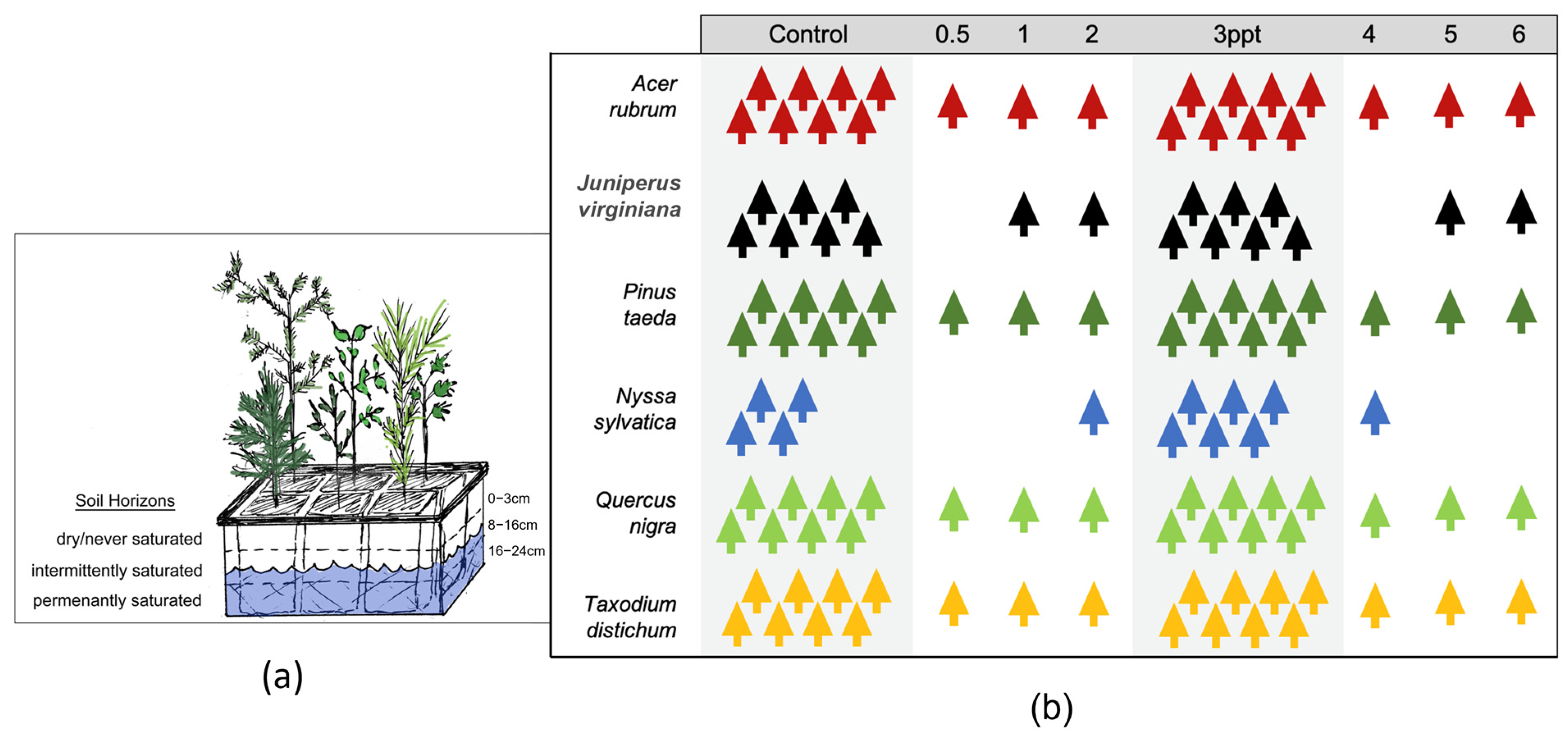


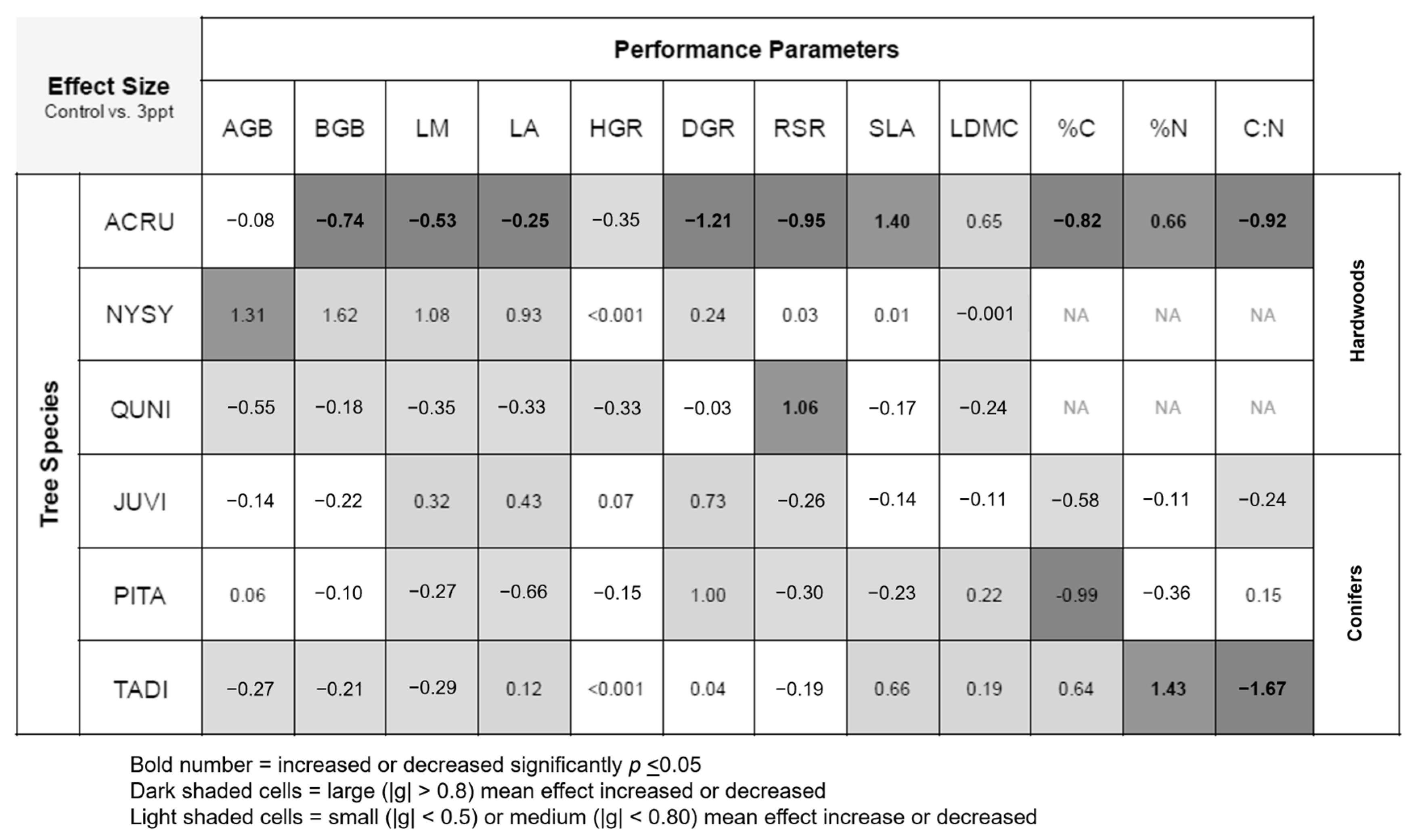
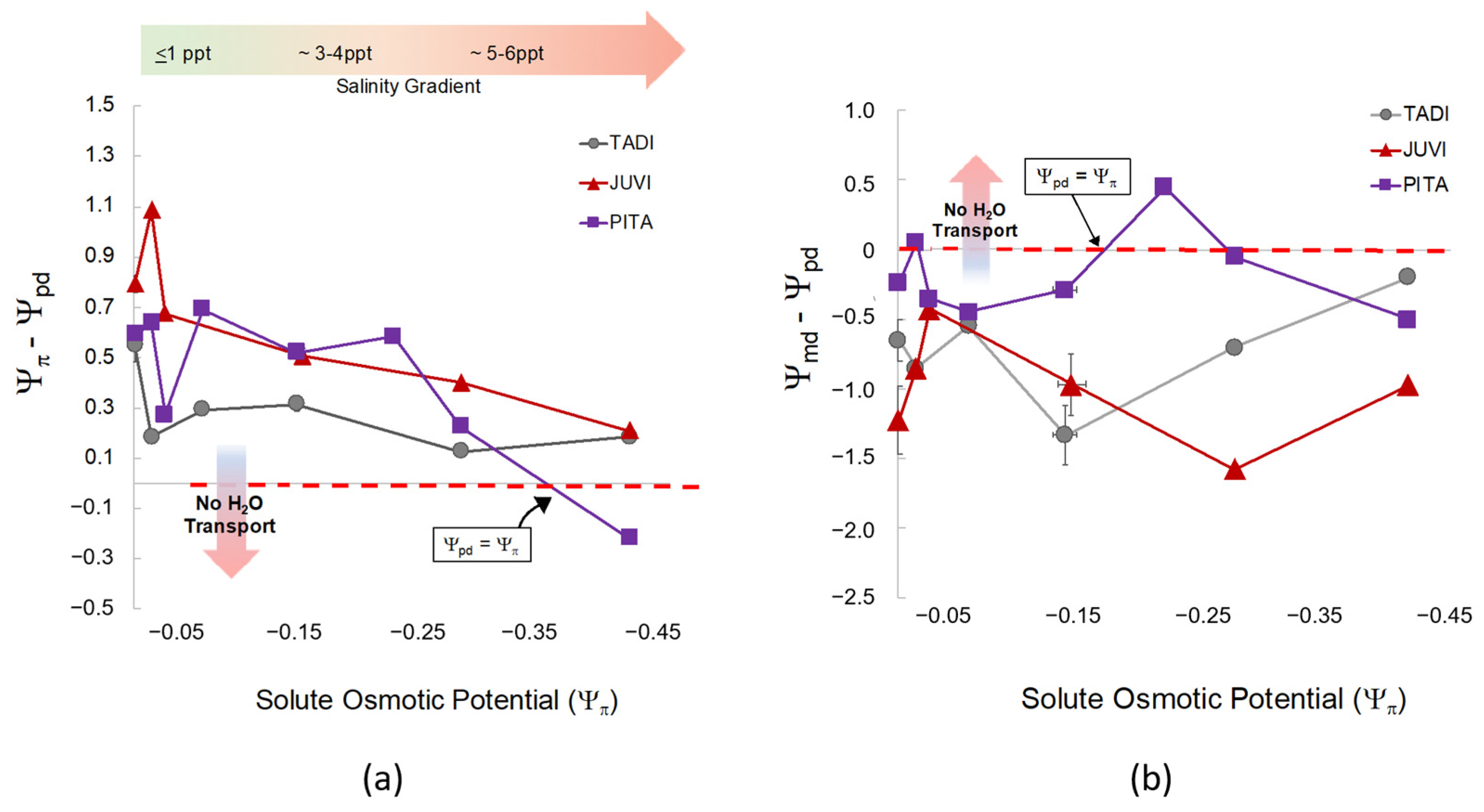
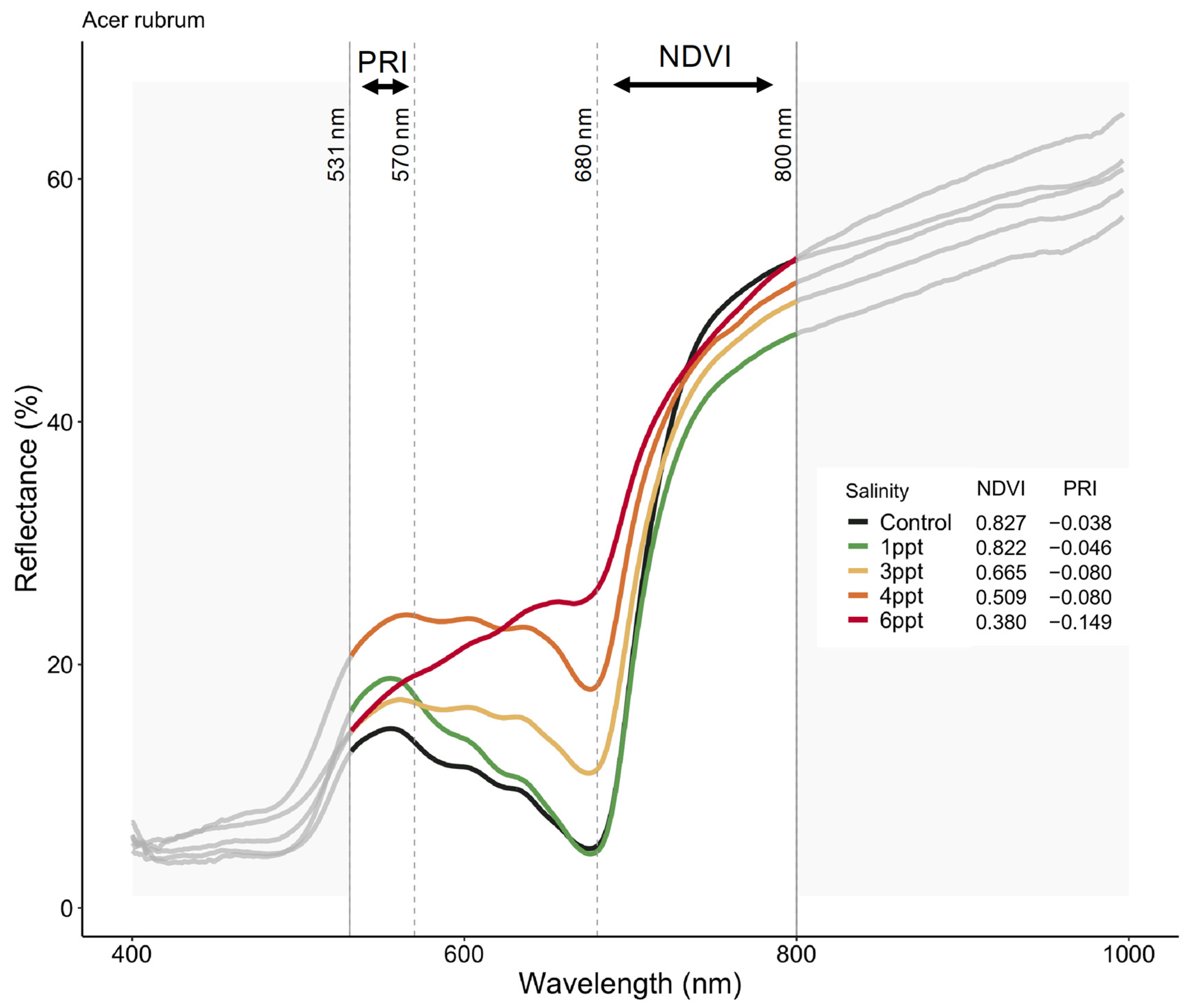
| Cl− mg/L | SO4− mg/L | Na+ mg/L | K+ mg/L | Ca+ mg/L | Mg+ mg/L | ||||||||
|---|---|---|---|---|---|---|---|---|---|---|---|---|---|
| Species | Min | Max | Min | Max | Min | Max | Min | Max | Min | Max | Min | Max | |
| Hardwoods | Nyssa sylvatica | 35.8 | 822 | 43.8 | 318 | 49.5 | 453 | 80.1 | 157 | 43.3 | 191 | 16.3 | 82.3 |
| Acer rubrum | 18.6 | 1276 | 22.7 | 628.4 | 36.7 | 691 | 23.5 | 201 | 26.5 | 183 | 7.9 | 90.0 | |
| Quercus nigra | 21.6 | 1363 | 50.8 | 492.2 | 38.6 | 712 | 47.6 | 194 | 29.5 | 251 | 14.2 | 109 | |
| Conifers | Juniperus virginiana | 21.3 | 2228 | 72.3 | 309 | 36.6 | 1196 | 57.6 | 169 | 35.5 | 232 | 128 | 121 |
| Taxodium distichum | 22.1 | 2344 | 20.7 | 523 | 36.2 | 1294 | 28.7 | 183 | 20.2 | 255 | 6.9 | 156 | |
| Pinus taeda | 21.9 | 2676 | 62.5 | 559 | 35.3 | 1340 | 44.6 | 287.1 | 25.9 | 323 | 9.4 | 187 | |
Disclaimer/Publisher’s Note: The statements, opinions and data contained in all publications are solely those of the individual author(s) and contributor(s) and not of MDPI and/or the editor(s). MDPI and/or the editor(s) disclaim responsibility for any injury to people or property resulting from any ideas, methods, instructions or products referred to in the content. |
© 2024 by the authors. Licensee MDPI, Basel, Switzerland. This article is an open access article distributed under the terms and conditions of the Creative Commons Attribution (CC BY) license (https://creativecommons.org/licenses/by/4.0/).
Share and Cite
Anderson, S.M.; Bernhardt, E.S.; Domec, J.-C.; Ury, E.A.; Emanuel, R.E.; Wright, J.P.; Ardón, M. Leaf Physiological Responses and Early Senescence Are Linked to Reflectance Spectra in Salt-Sensitive Coastal Tree Species. Forests 2024, 15, 1638. https://doi.org/10.3390/f15091638
Anderson SM, Bernhardt ES, Domec J-C, Ury EA, Emanuel RE, Wright JP, Ardón M. Leaf Physiological Responses and Early Senescence Are Linked to Reflectance Spectra in Salt-Sensitive Coastal Tree Species. Forests. 2024; 15(9):1638. https://doi.org/10.3390/f15091638
Chicago/Turabian StyleAnderson, Steven M., Emily S. Bernhardt, Jean-Christophe Domec, Emily A. Ury, Ryan E. Emanuel, Justin P. Wright, and Marcelo Ardón. 2024. "Leaf Physiological Responses and Early Senescence Are Linked to Reflectance Spectra in Salt-Sensitive Coastal Tree Species" Forests 15, no. 9: 1638. https://doi.org/10.3390/f15091638







